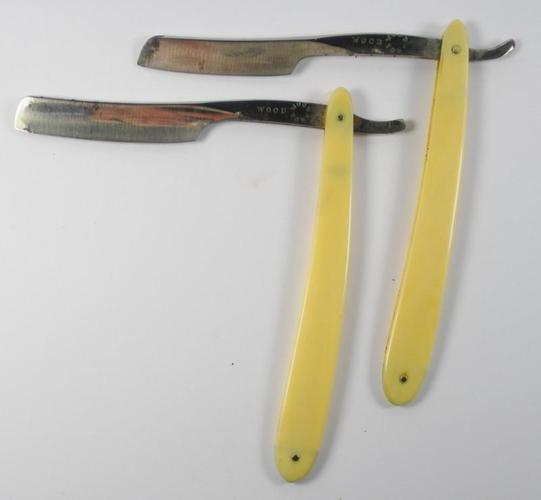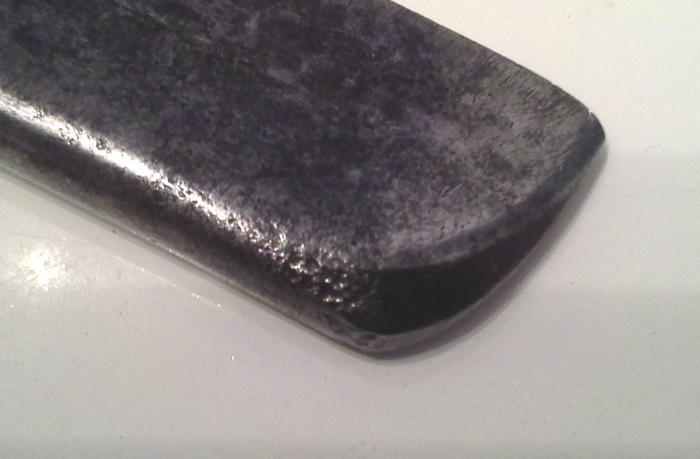Results 1 to 10 of 26
Thread: Newly arrived from England
Hybrid View
-
04-20-2014, 10:17 PM #1

That's a nice blade and I wouldn't worry about your strop. I've never had any experience of pitting damaging a strop.
You could always make a paddle strop, right ? Ten bucks for a piece of leather glued on to a 3" x 17" piece of wood.
Maybe it's my poor eyesight, but I can't really see any pitting worth worrying about.
That should clean up just fine....http://straightrazorplace.com/workshop/18504-welcome-workshop-how-do-i-where-do-i-what-do-i-answers-here.html
-
04-20-2014, 10:34 PM #2
-
04-20-2014, 10:55 PM #3

Hey mate, I'm certainly no expert but I might start with a medium grit wet'n'dry, say around 400# or 600#.
You can always go lower if you feel you're not making progress....
Best to put your pics in the "Workshop" forum and you'll get a much more knowledgeable response.
I can't help with the manufacturer's history but Martin is one of the go-to guys who could
I've only seen one other example of this manufacturer:

P.S. I always like to start a resto by giving the blade and scales a good soak in WD40 !!Last edited by bongo; 04-20-2014 at 11:11 PM.
http://straightrazorplace.com/workshop/18504-welcome-workshop-how-do-i-where-do-i-what-do-i-answers-here.html
-
04-21-2014, 01:18 AM #4

Lovely!
I'd guess those were made by Joseph Wood of York. He's listed in Baine's 1823 directory of York as: cutler, gunsmith and surgeon's instrument manufacturer in Spurriergate.
He was born 1775 in Bishopthorpe to Richard Wood and Elizabeth Prentice. In 1799, he married Elizabeth Stables at St. Michaels, Spurriergate. They had 8 children.
He died in 1843, aged 68.
Since it was made outside Sheffield's fashions, I'm a little bit at a loss to figure out when it was made, but It's very safe to say between 1823 and 1843! My guess would be early 1830's, but it's just a guess.
The scales are almost certainly black horn. In actual practice bakelite was pretty rarely used for razor scales. The most common black plastic used for scales was gutta percha, which is a kind of rubber. It was also called 'Ebonite' and it was very popular for things like mourning jewelry (in place of real ebony which was much more expensive).
I didn't even know there was a cutlery industry in York, and I'd never seen any of these razors. Awesome!
I wouldn't worry overmuch about the pitting on the spine. If you sand it down, you'll change the contact angle with the bevel, which could make honing a problem.-Zak Jarvis. Writer. Artist. Bon vivant.
-
-
04-21-2014, 01:23 AM #5Plausibly implausible





- Join Date
- May 2011
- Location
- Mount Torrens, South Australia
- Posts
- 5,979
Thanked: 485
I'd try and retain the patination, I think patina looks nice. And I'd agree I don't think the scales are bakelite. It looks like a nice razor...
Stranger, if you passing meet me and desire to speak to me, why should you not speak to me? And why should I not speak to you?
Walt Whitman
-
04-21-2014, 01:35 AM #6
-
04-21-2014, 01:48 AM #7

+1 to both Zak and Carl said. Go slow, don't try to do too much and stop when it looks right to you. That patina has been hard won over the last couple hundred years, so don't throw it away lightly.

There are very very few 'true' wedges out there, and most that are referred to as wedges are really near wedges, so odds are good that one is more or less as wedgy as it gets. A true wedge would be a monster to hone as you would have to be removing steel over the entire width of the blade. But when you add even in a bit of a hollow, you're then just dealing with the edge and the spine.
I would think that if you go over those pits on the spine lightly with some wet/dry and then maybe polish, you'll smooth their edges so that potential damage to the strop would be eliminated. In other words, don't try to remove the pits, but rather make sure they don't have any sharp edges. But to be honest I'd be surprised if they would do any damage to a strop to begin with. How do the pits feel when you rub with a finger?
That's a nice looking razor - good luck with it!Last edited by Cangooner; 04-21-2014 at 01:54 AM.
It was in original condition, faded red, well-worn, but nice.
This was and still is my favorite combination; beautiful, original, and worn.
-Neil Young
-
04-21-2014, 02:05 AM #8

Absolutely! The more I examine the razor, the more I like the patina. And Zak's amazing info astounds and humbles me..I most certainly don't want to destroy this old razor's personality!
Good point about the pits on the spine...when I rub my finger over them, the pits are actually quite smooth to the touch. I suspect that they've already been thoroughly burnished during untold years of honing and stropping.
I agree: this deserves a conservative, light touch.
-
The Following User Says Thank You to Dzanda For This Useful Post:
Voidmonster (04-21-2014)


 49Likes
49Likes LinkBack URL
LinkBack URL About LinkBacks
About LinkBacks






 Reply With Quote
Reply With Quote







